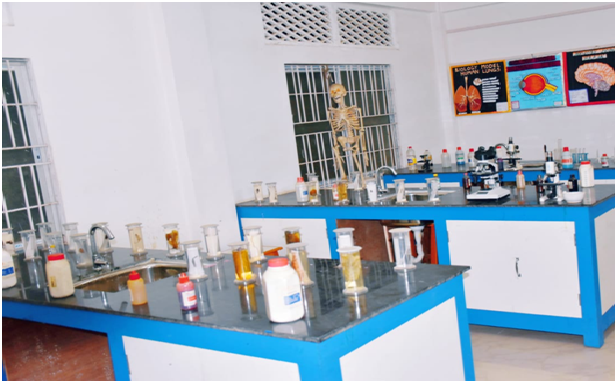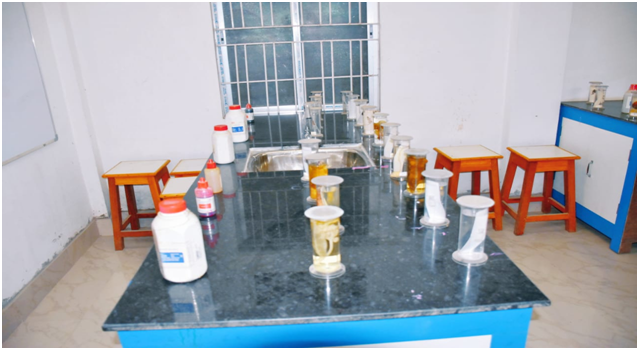| PRACTICAL FOR CLASS – XI | |
|---|---|
| Max. Marks : 30 | Time : 3 Hours |
| Evaluation Scheme | |
| One Major Experiment Part A (Experiment No- 1,3,7,8) | 5 Marks |
| One Minor Experiment Part A (Experiment No- 6,9,10,11,12,13) | 4 Marks |
| Slide Preparation Part A (Experiment No- 2,4,5) | 5 Marks |
| Spotting Part B | 7 Marks |
| Practical Record + Viva Voce | 4 Marks |
| Project Record + Viva Voce | 5 Marks |
| TOTAL | 30 Marks |
A : List of Experiments :
- Study and describe three locally available common flowering plants, one from each of the families Solanaceae, Fabaceae and Liliaceae (Poaceae, Asteraceae or Brassicaceae can be substituted in case of particular geographical location) including dissection and display of floral whorls, anther and ovary to show number of chambers (floral formulae and floral diagrams). Types of root (Tap and adventitious); types of stem (herbaceous and woody); leaf (arrangement, shape, venation, simple and compound).
- Preparation and study of T.S. of dicot and monocot roots and stems (primary).
- Study of osmosis by potato osmometer.
- Study of plasmolysis in epidermal peels (e.g. Rhoeo/lily leaves or flashy scale leaves of onion bulb).
- Study of distribution of stomata in the upper and lower surfaces of leaves.
- Comparative study of the rates of transpiration in the upper and lower surface of leaves.
- Test for the presence of sugar, starch, proteins and fats in suitable plant and animal materials.
- Separation of plant pigments through paper chromatography.
- Study of the rate of respiration in flower buds/leaf tissue and germinating seeds.
- Test for presence of urea in urine.
- Test for presence of sugar in urine.
- Test for presence of albumin in urine.
- Test for presence of bile salts in urine.
B: Careful observation of the following (spotting) :
- Parts of a compound microscope.
- Specimens/slides/models and identification with reasons - Bacteria, Oscillatoria, Spirogyra, Rhizopus, mushroom, yeast, liverwort, moss, fern, pine, one monocotyledonous plant, one dicotyledonous plant and one lichen.
- Virtual specimens/slides/models and identifying features of - Amoeba, Hydra, liverfluke, Ascaris, leech, earthworm, prawn, silkworm, honeybee, snail, starfish, shark, rohu, frog, lizard, pigeon and rabbit.
- Tissues and diversity in shape and size of plant cells (palisade cells, guard cells, parenchyma, collenchyma, sclerenchyma, xylem and phloem) through temporary and permanent slides.
- Tissues and diversity in shape and size of animal cells (squamous epithelium, smooth, skeletal and cardiac muscle fibers and mammalian blood smear) through temporary/permanent slides.
- Mitosis in onion root tip cells and animals cells (grasshopper) from permanent slides.
- Different modifications in roots, stems and leaves.
- Different types of inflorescence (cymose and racemose).
- Human skeleton and different types of joints with the help of virtual images/models only.
| PRACTICAL FOR CLASS – XII | |
|---|---|
| Practical Max. Marks 30 | Time Allowed: 3 Hours |
| Evaluation Scheme | |
| One Major Experiment 5, 6, 8, 9 | 5 Marks |
| One Minor Experiment 2, 3, 4 | 4 Marks |
| Slide Preparation 1, 7 | 5 Marks |
| Spotting | 7 Marks |
| Practical Record + Viva Voce | 4 Marks |
| Project and its Record + Viva Voce | 5 Marks |
| TOTAL | 30 Marks |
A : List of Experiments : 60 Periods
- Prepare a temporary mount to observe pollen germination.
- Collect and study soil from at least two different sites and study them for texture, moisture content, pH and water holding capacity. Correlate with the kinds of plants found in them.
- Collect water from two different water bodies around you and study them for pH, clarity and presence of any living organism.
- Study the presence of suspended particulate matter in air at two widely different sites.
- Study the plant population density by quadrat method.
- population frequency by quadrat method.
- Prepare a temporary mount of onion root tip to study mitosis.
- Study the effect of different temperatures and three different pH on the activity of salivary amylase on starch.
- Isolate DNA from available plant material such as spinach, green pea seeds, papaya, etc.
B : Careful observation of the following (spotting):
- Flowers adapted to pollination by different agencies (wind, insects, birds).
- Pollen germination on stigma through a permanent slide or scanning electron micrograph.
- Identification of stages of gamete development, i.e., T.S. of testis and T.S. of ovary through permanent slides (from grasshopper/mice).
- Meiosis in onion bud cell or grasshopper testis through permanent slides.
- T.S. of blastula through permanent slides (Mammalian).
- Mendelian inheritance using seeds of different colour/sizes of any plant.
- Prepared pedigree charts of any one of the genetic traits such as rolling of tongue, blood groups, ear lobes, widow's peak and colourblindness
- Controlled pollination - emasculation, tagging and bagging.
- Common disease causing organisms like Ascaris, Entamoeba, Plasmodium, any fungus causing ringworm through permanent slides, models or virtual images. Comment on symptoms of diseases that they cause.
- Two plants and two animals (models/virtual images) found in xeric conditions. Comment upon their morphological adaptations.
- Two plants and two animals (models/virtual images) found in aquatic conditions. Comment upon their morphological adaptations.

